Drying your mushrooms is an excellent way to make the most out of this powerful and delicious food. Not only will drying them maximize their shelf-life, dehydrated mushrooms can liven up dishes that need to pack a punch of flavor and can enhance their medicinal properties.
Want another reason to dehydrate your mushrooms? Doing so can allow you to access them during periods when they may not be growing. Mushrooms don’t fruit year-round, and your options are limited during the summer and winter.
To maintain the integrity of your mushrooms for long-term storage and medicinal applications, it is critical that you’re using the proper techniques to dry them. Storing them improperly puts your mushrooms at risk of getting damp and growing mold. Poor storage can also lead to bug infestations, which need I say more? Thankfully, when it comes to proper storage techniques, we’ve got you covered.
In this blog post, we’ll cover the many methods of drying mushrooms with step-by-step instructions, the benefits of drying them, and the best storage options to keep them at their peak.
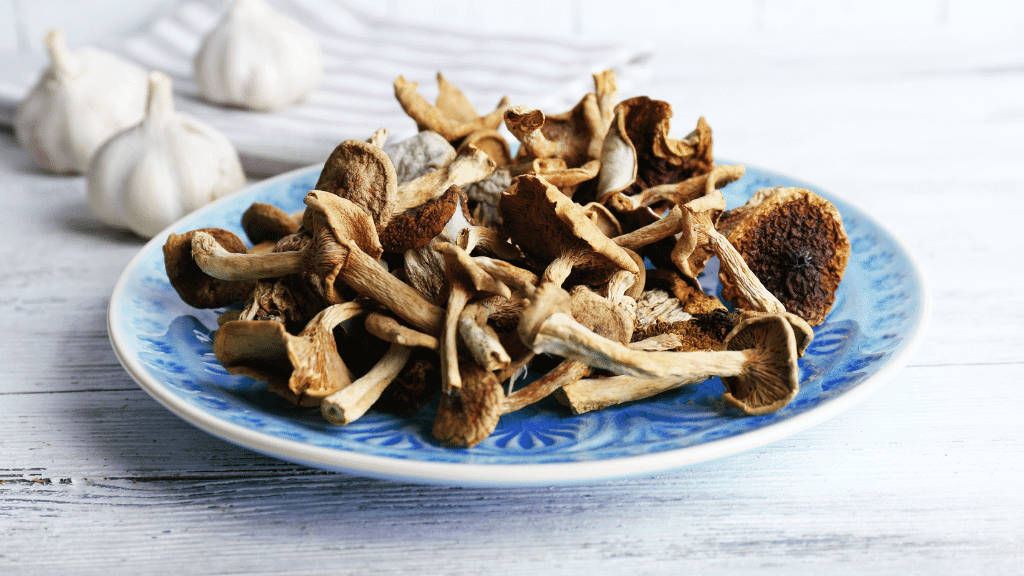
What are the methods of drying mushrooms?
If you’re wondering how to dry your mushrooms, you’re in luck! You have plenty of options to choose from, and many methods are easy, and involve little to no expense to you.
The best method of drying mushrooms is really a matter of personal preference. If we had to choose, we’d say that a commercial dehydrator is a sure-fire way of getting a consistently dried mushroom in a relatively shorter time. However, this is also one of the most expensive methods, so it’s best to weigh your options.
Need help deciding which method to choose? We break down the pros and cons of each method, so you can dry your mushrooms to store or use for medicine.
1. Air dry
Air drying your mushrooms is one of the easiest and cheapest methods to use as it requires no equipment. To get bone-dry mushrooms, you’ll have to make sure that the environment is below a certain humidity threshold. The cons to this method is that air drying can often take several hours to remove moisture from the mushrooms and the level of dryness can be inconsistent. Learn how.
2. Oven dehydrate with air dry
Are you looking for a faster way to get dry mushrooms with equipment you already have at home? This hybrid method using your oven paired with air drying can speed things up! Although this is a faster method, the drying consistency will still depend on the humidity of the environment the mushrooms will air dry. Learn how.
3. In an oven
You can skip the air-drying process by putting your mushrooms in the oven for longer. While this removes the uncertainty of an inconsistently dried mushroom, you will have to watch the mushrooms in the oven more carefully. Mushrooms dried out in the oven need to be flipped every 1-2 hours and dried for a total time of 4-8 hours. The temperature to heat may also be lower than what your oven offers. Learn how.
4. In a commercial dehydrator
Using a commercial dehydrator is a great choice to remove moisture from mushrooms in an even and consistent way. This method will gently dry out your mushrooms using a soft heat element paired with continual airflow. The biggest downside to this method is that dehydrators can be expensive. Commercial dehydrators can range from several hundred dollars into the thousands, depending on how many mushrooms you’d like to dry at a time. Learn how.
5. A desiccant
Drying your mushrooms with a desiccant is another easy and cost-effective way to dry mushrooms. A desiccant saps moisture from its environment, and when put in a container of pre-dried mushrooms can be an excellent way of completely drying them out. Its main con is ensuring that you’ve done a thorough pre-dry process of your mushrooms. Some desiccants are also less environmentally friendly than others. Learn how.
Let's dive into each of these methods in more detail:
How to air dry mushrooms
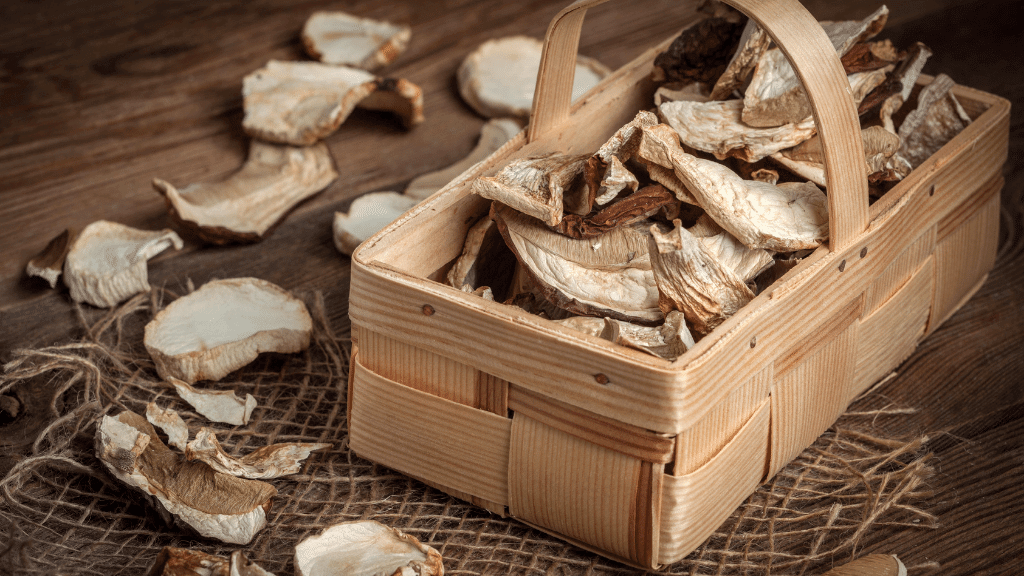
Air drying mushrooms is the simplest and cheapest way to dry your mushrooms. This option requires no special equipment, which means no extra expenses.
There are two ways to air dry mushrooms. You can take the easiest approach of simply allowing them to air dry until they’re dry enough to store, or you can oven dehydrate them before air drying to speed up the process.
Below are steps on how to air dry them without an oven:
- Wipe your fresh mushrooms clean with a damp paper towel and place them in an open air container like a colander, so there is easy air flow. Make sure that the mushrooms are not touching.
- Slice your mushrooms to your desired thickness.
- Place the mushrooms in an area with plenty of air circulation. Near the sun is best.
- Allow the air mushrooms to air dry for about 7 to 10 days. The drying time will depend on the size of the mushroom and the humidity of the environment where the mushrooms are drying.
- Test your mushroom’s moisture levels by giving them a squeeze. Completely dried mushrooms will not give once you squeeze them.
Oven dehydrate before air drying
To speed up the process of air drying, some mushroom aficionados will oven dehydrate them first in the oven for two hours.
Here’s how to do it:
- Preheat your oven to 175 degrees Fahrenheit / 80 degrees Celsius
- Place your well spaced out mushrooms into the oven in an oven safe dish or baking sheet
- Flip your mushrooms after an hour
- Remove your mushrooms at the two-hour mark
- Move them to a colander and let the mushrooms air dry an additional 3 to 5 days
Fun fact: A fully dried mushroom will give off a strong aroma and is a key indicator that you’ve finished your drying process.
How long can you store dried mushrooms?
You can store your dried mushrooms in a sealed container for an entire year!
How to dry mushrooms in the oven
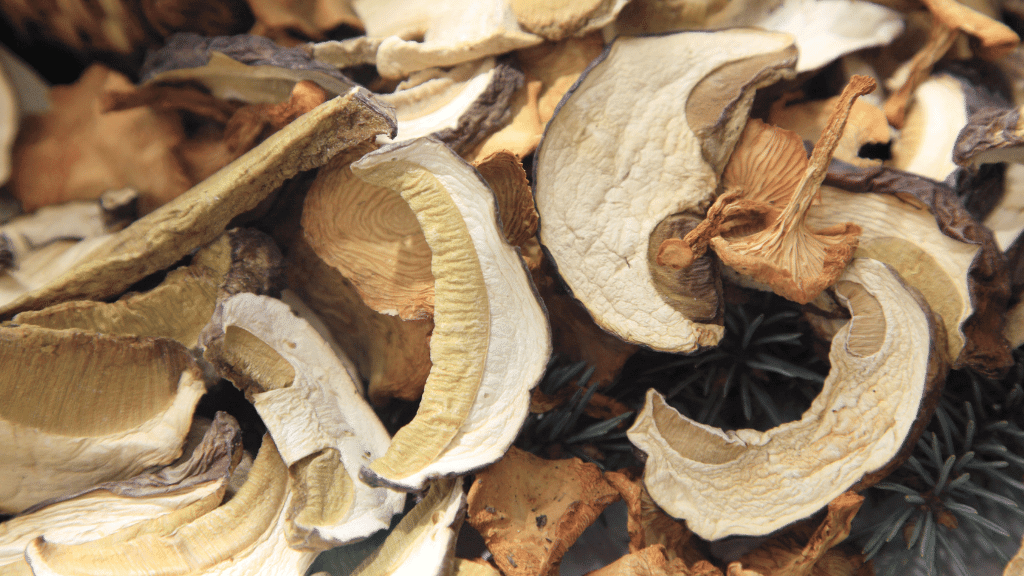
Are you short on time? You can skip the air drying process and accelerate the time to dry your mushrooms significantly by using an oven.
This method will allow you to dry your mushrooms in about 4-8 hours, versus the air drying method, which can take several days.
Here’s a step-by-step guide to drying your mushrooms in the oven:
- Heat your oven to 130 degrees Fahrenheit/ 54 degrees Celsius.
- Like the air drying method, you’ll want to make sure that you prep your mushrooms by wiping them down and slicing them to your preference.
- After you’ve prepped your mushrooms, simply space out your mushrooms in an oven safe container and pop them in the oven.
- Remove your mushrooms from the oven every 1 to 2 hours to blot them dry and then turn them over.
- Repeat this process every couple of hours until you’ve baked them in the oven for a total of 4 to 8 hours.
- Take the mushrooms out of the oven and allow them to cool, where they will continue to crisp up.
Bonus tip: If you're unable to set your oven’s temperature to as low as 130 degrees Fahrenheit/54 degrees Celsius, then keep the oven door open. This will cool off the temperature inside the oven, while also improving air circulation and allowing your mushrooms to dry better.
How to dry mushrooms in a dehydrator
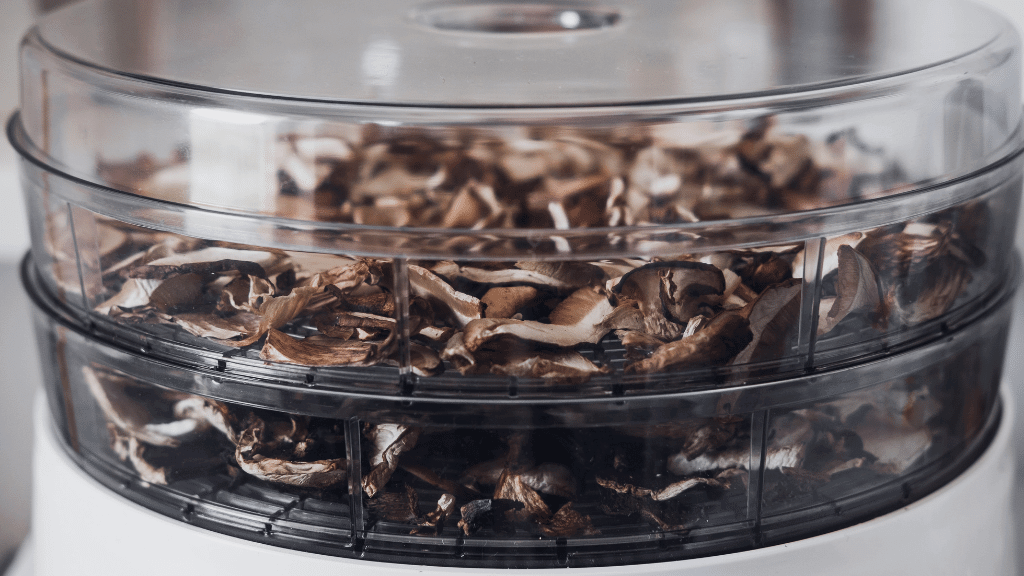
Want a consistently dried mushroom every time? Prefer more of a set it and forget it mushroom drying method that requires little babysitting? Is long-term storage and minimal risk of contamination a priority? If you answered yes to any of these questions, then using a dehydrator to dry your mushrooms may be right for you.
But first, what’s a dehydrator?
A dehydrator is a device that removes moisture from substances using heat and air circulation. The heat will sap water from the mushrooms, while the fan will blow the hot air out of the dehydrator. This is superior to the oven drying method because there is no excess heat trapped in the device.
What kind of dehydrator should you use?
There are many options to choose from, but any food dehydrator will get the job done! Your biggest consideration may be your budget, as a dehydrator can often be expensive.
How long will it take to dry your mushrooms in a dehydrator?
Using a dehydrator will dry your mushrooms somewhere between 4 and 12 hours. Several factors affect drying time including: humidity, thickness of the cut mushrooms, and the size of your dehydrator.
Here’s how to dry your mushrooms in a dehydrator:
- Wipe down your mushrooms, so that they’re clean and slice them to your liking
- Pat the mushrooms to remove any excess water
- Place your mushrooms in a single layer in your dehydrator
- Set the dehydrator temperature to 125 degrees Fahrenheit/52 degrees Celsius
- Leave the mushrooms in the dehydrator until they have a leathery consistency (this can be achieved in 4 to 12 hours)
Note: Although it’s not required, it might be worth checking on your mushrooms every hour until you have a better sense of how long they should be kept in the dehydrator. Once you’ve developed a consistent process, checking them may not be needed.
This method is one of the best ways to dry your mushrooms. However, it is the most expensive, so consider how often you’ll use a dehydrator before committing to a pricey purchase.
Using a desiccant to dry mushrooms
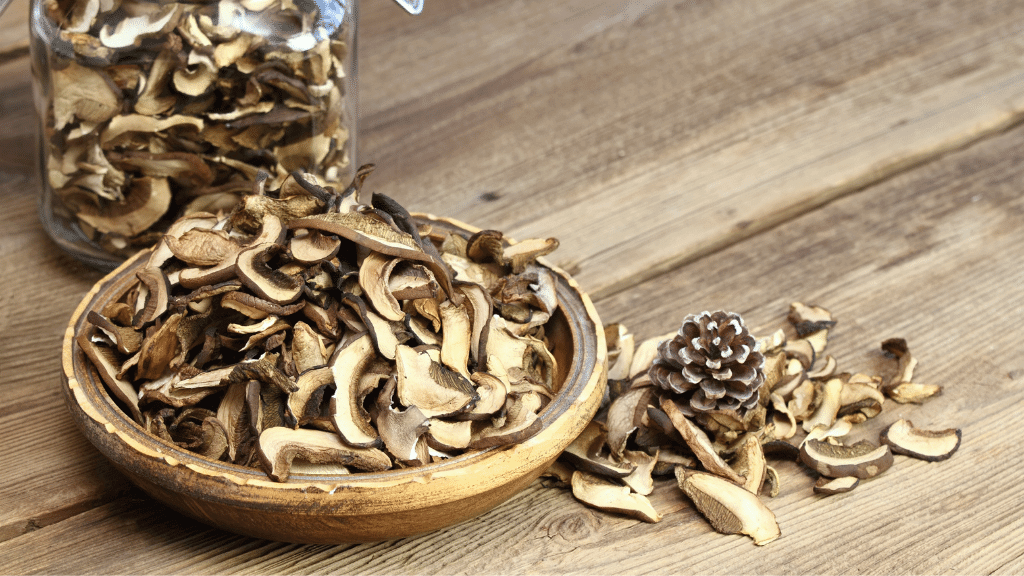
Using a desiccant is another easy and cheap method to dry your mushrooms. You can even cut the costs of this method if you make your own desiccant, since most materials needed are generally ones you already own.
Be warned, however, this process can be more time-consuming and require a little more attention to detail, compared to drying with more sophisticated equipment like ovens and dehydrators.
If you’re more of a DIY person, then this might be the right option to dry your mushrooms.
What is a desiccant?
A desiccant is a material that removes moisture from environments to maintain a state of dryness and freshness. You’ve likely seen silica gel packets, the most common desiccant, in bottles of vitamins or inside of shoes or purses.
How to make your own homemade desiccant
Materials list:
- Store-bought Epsom salt
- Baking tray
- Hammer
- Airtight, heat-resistant container
- Oven
Steps to make a desiccant
- Preheat your oven to 450-475 degrees Fahrenheit or about 230-250 degrees Celsius
- Pour 1 cm layer of Epsom salt onto a baking tray
- Place your baking tray of Epsom salt into the oven and leave it for 2 hours
- At the two-hour mark, quickly remove your tray from the oven and immediately use a hammer to break up the salt cake that has formed
- Remove the still hot substance from the tray and place it in airtight containers as soon as possible to ensure that moisture won’t be added back to it
- Voila! You now have desiccant you can use and reuse for future mushroom drying sessions
Whether you’ve made your own desiccant or purchased one, dehydrating your mushrooms with this method can be done easily. Here’s how to do it.
How to dry your mushrooms with a desiccant.
- Using a plastic container with an airtight lid, place your desiccant at the bottom of the container
- Add a layer of paper towels on top of the desiccant
- Place a metal mesh in the container so that it acts as a platform (this prevents the mushrooms from touching the paper towels and the desiccant)
- Place your clean and pre-cut mushrooms into the top of the metal mesh
- Put the airtight lid on the container
- Let the desiccant absorb the moisture from the mushrooms and check back every couple of days until they’re ready (you’ll know they’re done if they have a brittle consistency)
What are the benefits to drying mushrooms?
From retaining a deep and satisfying flavor to prolonging their use, there are many benefits to drying mushrooms. Here’s why we like to dehydrate mushrooms.
- Dried mushrooms maintain a savory taste. Drying your mushrooms can help them retain a deep umami flavor that allows you to use them in a variety of broths, soups, stocks, casseroles, stews, and stir fries.
- They extend the shelf life of your mushrooms. A fresh mushroom can stay fresh about a week if cared for properly. Dried mushrooms, on the other hand, can last indefinitely if stored in an airtight container in a cool, dark place. To rehydrate your dried mushrooms, simply add water and cook as usual.
- Dehydrated mushrooms can have powerful health benefits. Some dried mushrooms, like Shiitake, have been revered as a good, non-animal source of iron. Many dried mushroom varieties also contain several nutrients like enzymes, B-vitamins (especially niacin), vitamin D2, and protein.
- Dried mushrooms can be consumed in several ways. Drying them allows you to consume this in many ways, whole, in powder form that can be mixed into drinks or even capsuled to take into pill form.
What mushrooms can be dried?
All mushrooms can be dried, although some may take longer than others. You can use drying methods for gourmet, medicinal, and any other type of wild or commercially-grown mushroom.
How to store your dried mushrooms
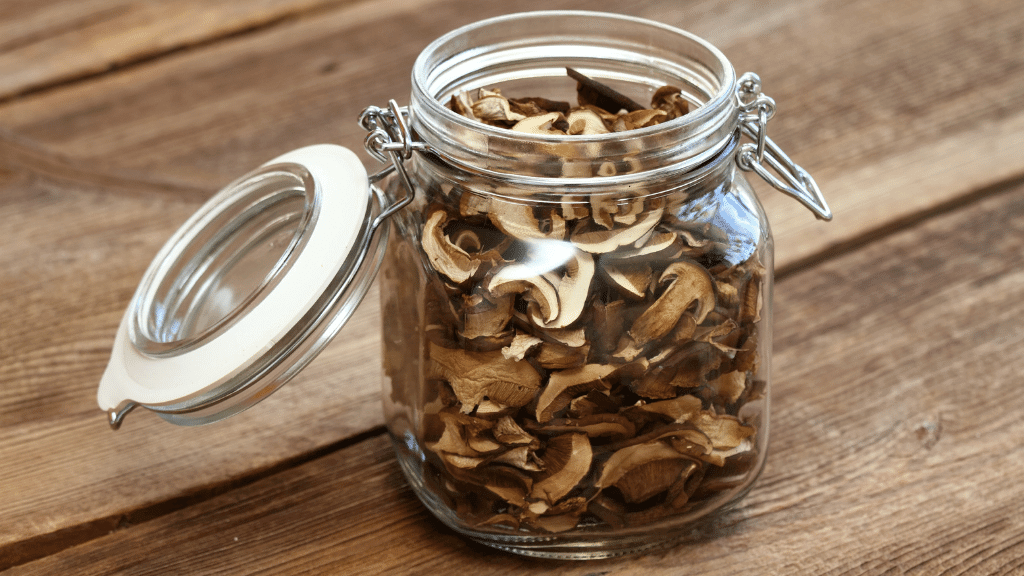
The best way to store your dried mushrooms is in an airtight container to prevent moisture from seeping back in and rehydrating them. You’ll also want to keep them in a cool, dark place, such as a basement or cupboard, to prevent them from lightening in color, which can reduce the mushroom’s flavor..
Here are a few dried mushroom storage options:
1. Glass jars
For the best long-term storage, keep them in a glass jar, like a mason jar. Glass jars are often preferred because they keep an airtight seal and allow you to see your mushrooms.
2. Stainless steel containers
Our second favorite storage option is a stainless steel container, which can offer excellent humidity control. They can often increase the potency of a substance’s aroma and flavor.
3. Vacuum sealed containers
Another great option to maximize the shelf-life of your mushrooms is using a machine to vacuum seal them. This protects your mushrooms from oxygen and keeps them intact from any degrading elements. This is one of the priciest storage options, though.
Bonus tip: Add a desiccant, like a silica gel packet or your homemade desiccant, to any of your storage containers, so that it removes any remaining moisture.
Does drying mushrooms impact their potency or nutritional value?
For the most part, drying is a safe and effective way to maintain the integrity of the mushroom's medicinal and nutritional value.
According to this study, drying can increase the phenolic compounds of a mushroom, which can have some potential advantages for antioxidant and other biological activities.
Want to learn how to get the most health value out of your dried mushrooms? Discover how to extract mushroom powder for the most benefit.
Once you've dried your own mushrooms, check out our blog on grinding them for use!

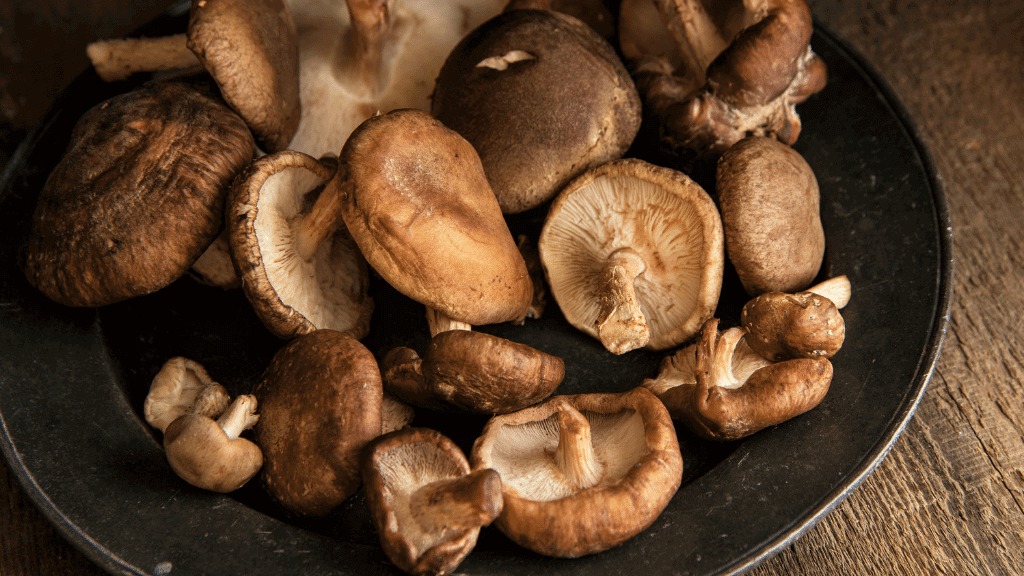
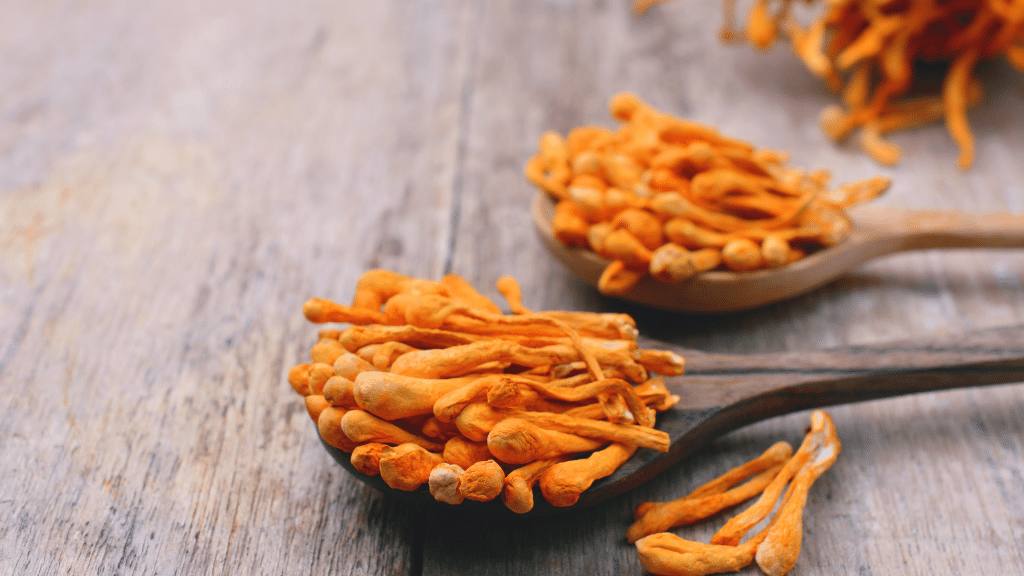


.png)
